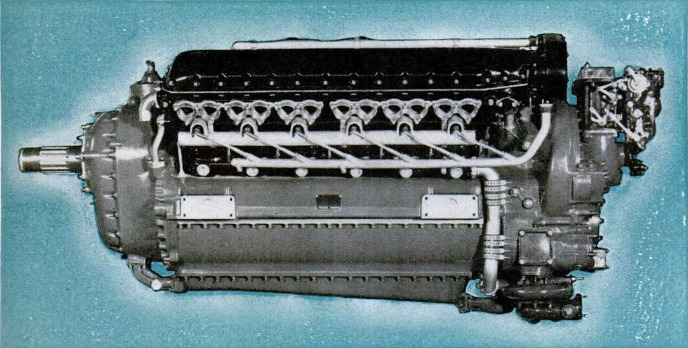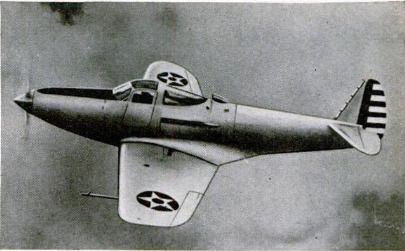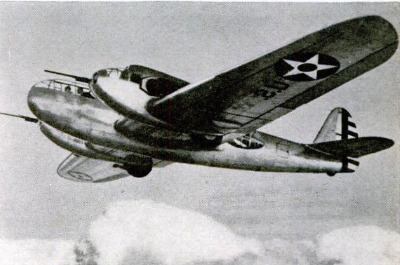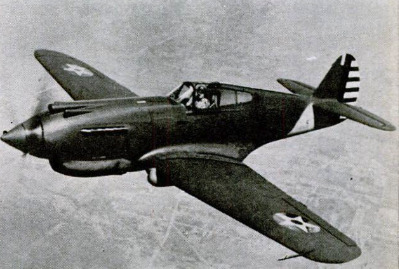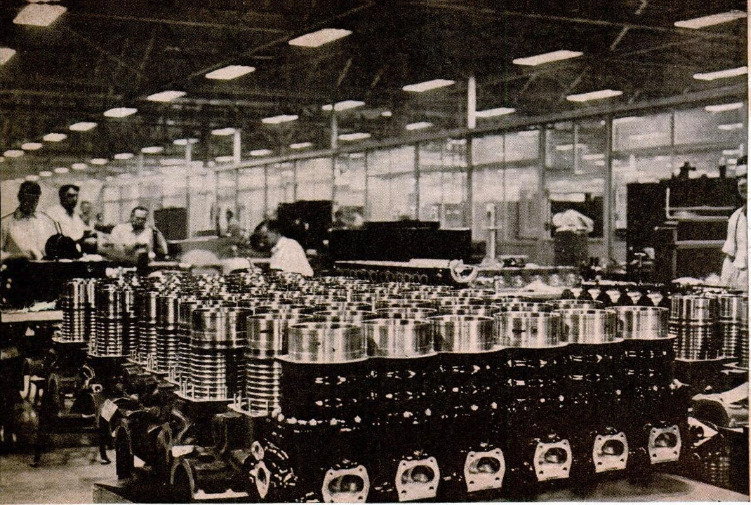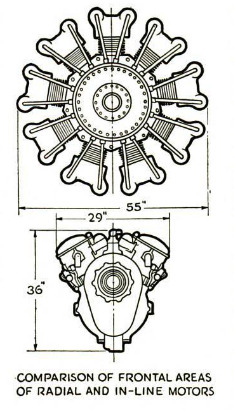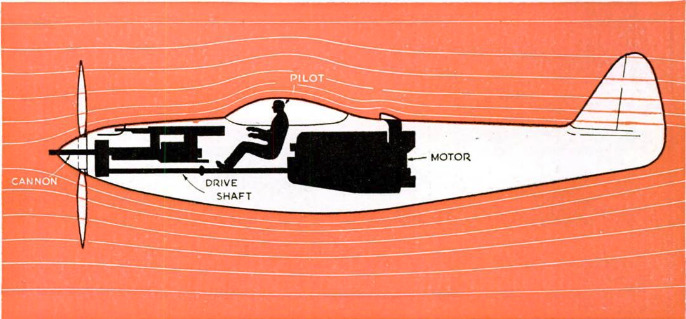-
Title (Dublin Core)
-
Streamline motors for streamline planes
-
Article Title and/or Image Caption (Dublin Core)
-
Streamline motors for streamline planes
-
extracted text (Extract Text)
-
HERE and there in the United States,
like ganglia in a vast nervous sys-
tem, factories are working at top
speed in the production of power
plants. The world is fighting a war of mo-
tors. The explosions in engine cylinders
have become as important as the explosions
in cannons and machine guns. The quick
production of bigger and better engines for
planes and tanks is a front-page problem
of the day.
The more significant of these two engines
of war is the motor used to power pursuit
planes and bombers, the combatant and
striking arms of the air force. Because of
the great speed required in aerial tactics,
motors for warplanes are now generally of
1,000 horsepower or more. In this country
there are three manufacturers of such en-
gines that are now on a production basis.
Two—Pratt and Whitney, and Wright—are
established manufacturers of high-power
radial motors. By December, each will be
turning out 900 of these air-cooled power
plants a month. The third is the Allison Di-
vision of General Motors at Indianapolis,
which makes the Allison liquid-cooled mo-
tor, ranging from a twelve-cylinder job
rated at 1,090 take-off horsepower, to a
twenty-four-cylinder job, now in the ex-
perimental stage, tentatively rated at 2,300.
The company sometimes ships as many as
four or five engines a day, sometimes less.
This winter when its present production
plant will have been doubled, the manage-
ment expects it will be turning out 100 en-
gines a week, or 5,200 a year. The engine
has already been accepted as the power
plant for the Curtiss P-40 and the Bell P-39
(Airacobra), both single-engine pursuits:
the Bell FM-1 (Airacuda), a
twin-engine multi-place fighter;
the Bell XFL-1 (Airabonita), a
Navy single-engine fighter; and
the Lockheed P-38, a twin-engine
interceptor. This acceptance was
based on a model test, applied by
the Government to motors made
in the experimental shop. The
Allison has yet to pass the pro-
duction-type test, which is ap-
plied to the engine made in quan-
tity in the factory.
If the production of Allison en-
gines meets the managers’ ex-
pectations, the country’s annual
rate of production of high-pow-
ered engines will be about 27,000.
This will be enough to power 18,-
000 planes, for one engine should
be held in reserve for every two
in service. However, since many
models will need either two or
four engines, the number of
planes will be about 12,000.
One of the reasons why ti
Government looks with hope :
the Allison engine is that higl
powered motors, up to now, hay
been put out by companies sp:
cializing in their manufactur
Allison, however, is an engir
controlled and sponsored by Ger
eral Motors, a fact that he
caused the governmental and poj
ular belief that the industry
now going to achieve mass pre
duction. This supposition hs
been based partly on the furth
fact that Allison, in a way, is
descendant of the Liberty engir
of World War I, a mass-produce
motor of 400 horsepower.
However, there is a great di
ference between the effort of 19]
and the effort of 1940. The Lil
erty engine failed as a militar
weapon abroad chiefly for tk
reason that the design engineer
had too short a time to do the jol
That they had the right idea we
proved by the performance of tk
Liberty after the War. The All
son engine will also be mass pre
duced, but under more favorab
conditions. There has been su
ficient development time, and o
ders for the engine have made
possible for General Motors to tool up. In-
deed, the preparation has been so thorough
that General Motors can actually build bet-
ter engines by mass-production tools tech-
nique than can ever be built by hand. The
finest handcraftsman cannot duplicate the
accuracy of American machine tools. The
problem is not so much in the application of
the methods of mass production as it is in
the adjustment of tools to operations upon
materials that hitherto have not been sub-
ject to such machining. This is a matter of
observation, adjustment, and practice in op-
eration. Actually there are many tolerances
in General Motors’ gasoline automotive en-
gines, and especially in its Diesel engines,
that are as fine as those in the Allison.
There are, however, more parts of the Al-
lison engine that require micrometric atten-
tion to limits than there are in the other
General Motors engines.
THE Liberty, which was also a V-type
liquid-cooled engine, was rebuilt after
the War in the very shops near the Indian-
apolis Speedway where Norman Gilman, an
ingenious Yankee mechanic who had
worked with Jim Allison on the old Lib-
erties, planned the first Allison. Convinced
that the engine of the future would be liquid
cooled, he discarded water as a cooling agent.
and designed an engine especially for the
use of a chemical cooler. This was in 1931,
two years after the Allison plant had been
bought by General Motors. On April 23, |
1937, the first Allison motor passed the 150-
hour test and the long struggle to get it
into mass production began.
The engineers who are bringing it into |
production give three major reasons for
their belief that it may prove superior to |
the air-cooled radial types to which most of
our productive capacity has been devoted.
Their reasons are: first, the air resistance,
or “drag,” is less than in the radial; second, |
the Allison can be divorced from the usual |
position directly behind the propeller; third,
it can maintain top speed for a longer time
than the air-cooled motor.
The claim of less drag is based chiefly on |
the difference in frontal areas; the twelve |
cylinder Allison has a frontal area of six
and a quarter square feet as against an area
of over sixteen square feet in the radial en-
gine of the same horsepower. The lower
area is a result of the V-shaped design, in
which the cylinders are in line, arranged
along a crankshaft, instead of protruding in
the sunburst arrangement of the air-cooled
radial. Drag increases as the square of the
speed: if the speed is doubled, the air re- |
sistance becomes four times as great.
Distinctly more important is the fact that |
the Allison engine, being cooled by the flow
of liquid around its cylinders instead of by
a flow of air, need not be directly exposed to
the air. It can be completely hidden in the
wings or go back toward the tail. This |
freedom of the engine position gives the de-
signer a greater opportunity to design for
maneuverability, which modern war tech-
nology and tactics may prove to be more
important in combat than a few more miles
an hour. The Airacobra is a case in point.
Here the weights of the engine, the pilot,
‘and the fuel are clustered around the ship's
center of gravity. Here, again, fast han-
dling of the ship is helped by the better com-
bat and searching vision afforded by the
pilot's position over the leading edge of the
wing. Moreover, this plane requires a fuse-
lage only thirty-four inches
wide—less than six times the
width of this page—to take
the compact Allison.
The Allison engine can
maintain top speed longer be-
cause it is easier to cool. In-
stead of water, which was
used in the Liberty engine,
the cooler is ethylene gly-
col, the same chemical used
in nonevaporating automo-
bile antifreeze solutions.
Ethylene glycol is a by-prod-
uct of the synthetic produc-
tion of glycerin. Its boiling
point is 387 degrees, com-
pared with the 212 degrees of
water. The pump forces it
through the engine so swift-
ly that the heat dissipation
is uniform in all cylinders.
That's the Allison side of
it. There are engineers, es-
pecially among the makers of
air-cooled engines, who are
not certain that Allison is all that its back-
ers claim. Most of them accent the stream-
lining advantages, but they find them offset
by the problems of installation. But this is
a technical debating ground, where time and
research will settle the question.
The name “Allison” is a remembrancer of
Jim Allison, who, with Carl Fisher, founded
the Prest-O-Lite Co. and later established
the Indianapolis Speedway so that they
could play with racing cars. Allison put up
a machine shop to design and service the
cars and gathered a staff of engineers and
mechanics, whose superintendent, when the
U. 8. entered the World War, was Norman
Gilman, an old-fashioned Yankee mechanic.
‘When the war ended and surplus Liberty en
gines were being overhauled,
Allison obtained a contract to
do some of the work. It was
then that Gilman invented
the famous Allison bearing—
bronze integrated with steel
—which solved the problem
of getting more horsepower
out of the Liberties. When
Allison died and General Mot-
ors bought the plant (1929)
to secure for development the
bearings and a Diesel engine,
then being designed, Gilman
was made president and gen-
eral manager of the new divi-
sion. He built gears and pro-
peller drives for the Navy
dirigibles and many special
engines; and began his study
of the liquid-cooled type
through work on the German
engines on the Los Angeles,
our trophy of the World War.
The air-cooled engine had at-
tained about 400 horsepower.
but Gilman, like one or two other engineers,
became firmly convinced that the liquid-
cooled type of power plant was destined to
be the airplane engine of the future,
-
Language (Dublin Core)
-
eng
-
Date Issued (Dublin Core)
-
1940-12
-
pages (Bibliographic Ontology)
-
62-65
-
Rights (Dublin Core)
-
Public domain
-
Archived by (Dublin Core)
-
Sami Akbiyik
-
Marco Bortolami (editor)
 Popular Science Monthly, v. 137, n. 6, 1940
Popular Science Monthly, v. 137, n. 6, 1940

